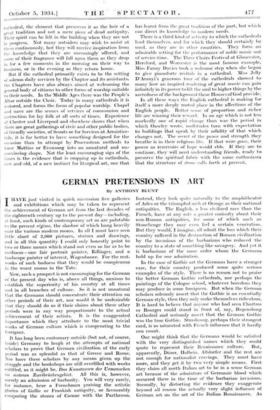GERMAN PRETENSIONS IN ART
By ANTHONY BLUNT
IHAVE just visited in quick succession five galleries 1 and exhibitions which may be taken to represent the achievement of German art from the lait decades of the eighteenth century up to the present day—including, at least, such kinds of contemporary art as are palatable to the present, regime, the shadow of which hung heavily over the various modern rooms. In all I must haveseen little short of 2,000 pictures, statues and drawings, and in all this quantity I could only honestly point to two or three names which stand out even so far as to be mediocre-.-one fair portrait painter, Edlinger, and a landscape painter of interest, Wagenbauer. For the rest, works of such badness that they would be conspicuous in the worst rooms in the Tate.
New, such a prospect is not encouraging for the German of the present day who is, above all things, anxious to establish the superiority of his country at all times and in all branches of culture. So it is not unnatural that the Germans should concentrate. their attention on other periods of their art, nor would it be undesirable that they should do so if their claims about these other periods were in any way proportionate to the actual achievement of their artists. It is the exaggerated importance which they attribute to the most trivial works of German culture which is exasperating to the foreigner. . .
It has long been customary outside (but not, of course, inside) Germany to laugh at the attempts of national scholars to prove that German civilization of the early period was as splendid as that of Greece and Rome. Nor have these scholars by any means given up the struggle and the bookshops are still overfilled with works entitled, as it might be, Das Kunstwesen der Urmenschen ina unteren Zweibrilekengebiet. All this is, . however, merely an admission of barbarity. You will very rarely, for instance, hear a Frenchman praising the artistic glories of Gallic or Frankish antiquity, or favourably comparing the stones of Carnac with the Parthenon. Instead, they look quite naturally to the amphitheatre of Arles or the triumphal arch at Orange as their national antiquities. The English, a less civilized race than the French, have at any rate a greater curiosity about their non-Roman antiquities, for some of which such as Stonehenge they may even feel a certain veneration. But they would, I imagine, all admit the loss which their country suffered in the destruction of Roman civilization by the invasions of the barbarians who reduced the country to a state of something like savagery. And yet it is barbarians Of the same order whom' the Germans hold up for our admiration.
In the case of Gothic art. the Germans have a stronger case, for their country produced some quite serious examples of the style. There is no reason not to praise the better German Gothic cathedrals, nor perhaps the paintings of the Cologne school, whatever boredom they may produce in some foreigners. But when the German scholars solemnly assert that the Gothic is an essentially German style, then they only make themselves ridiculous. It is hard to believe that anyone who had seen Chartres or Bourges could stand in front of, say, Regensburg Cathedral and seriously assert that the German Gothic was the true Gothic. Strasbourg, perhaps their strongest card, is so saturated with French influence that it hardly can count.
One might think that the Germans would be satisfied with the very distinguished names which they could quote to represent their Renaissance culture. But, apparently, Diirer, Holbein, Altdorfer and the rest are not enough for nationalist cravings. They must have more, and they get it by two very simple means. First they claim all north Italian art to be in a sense German art because of the admixture of Germanic blood which occurred there in the time of the barbarian invasions. Secondly, by distorting the evidence they exaggerate beyond all reason the actually very slight influence of German art on the art of the Italian Renaissance. As an extreme instance of this I would quote an ardent young National-Socialist Kunstforscher who tried to prove to me that all the good in. Raphael derived from Germany. I forget his arguments.
The case of the Baroque is the most difficult of all, and here the Germans can produce serious arguments for their view that the Baroque is Germanic in origin and that the best work in this style was produced in the Germanic-speaking countries. It certainly looks as though Germany might have produced spontaneously a Baroque style of its own if its entire cultural tradition had not been broken up by the Thirty Years War. On the other hand it is quite clear that the Baroque did actually originate in Rome, and though it was largely produced by the influence of north Italian artists that is, to us, no argument for its German origin. On the other hand, again, it would seem that the Germans were right in claiming that the Baroque reached its fullest development with them, and it could easily be argued that the style evolved in the early eighteenth century in Bavaria by such artists as the Asam brothers combined the qualities of all the Baroque traditions of Italy into a single quintessential form.
The general situation would be considerably easier for all parties if the Germans would admit that in the visual arts they had till now been mainly borrowers— that there is nothing discreditable in this is proved by the history of French painting which stole systematically for centuries—and, instead of putting laurels on their imaginary past, bring up from the cellars, to Which they have been condemned as showing dangerous Marxist tendencies, the works of their few contemporary artists who show some tendency to be leaders in European painting.











































 Previous page
Previous page